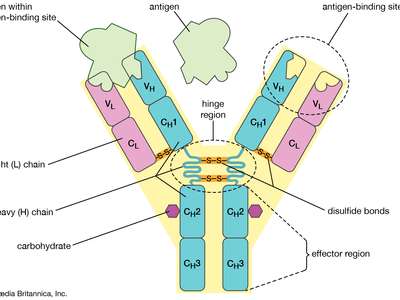Antibody is a protective protein produced by the immune system in response to the presence of a foreign substance, called an antigen.
They recognize and latch onto antigens in order to remove them from the body, according to britannica.com.
It said that a wide range of substances are regarded by the body as antigens, including disease-causing organisms and toxic materials such as insect venom.
How antibodies work
When an alien substance enters the human body, the immune system is able to recognize it as foreign because molecules on the surface of the antigen differ from those found in the body, it said.
Antibodies are produced by specialized white blood cells called B lymphocytes, also called B cells.
When an antigen binds to the B-cell surface, it stimulates the B cell to divide and mature into a group of identical cells called a clone.
The mature B cells, called plasma cells, secrete millions of antibodies into the bloodstream and lymphatic system, according to britannica.com.
As antibodies circulate, they attack and neutralize antigens that are identical to the one that triggered the immune response, it said.
According to britannica.com, antibodies attack antigens by binding to them. The binding of an antibody to a toxin, for example, can neutralize the poison simply by changing its chemical composition; such antibodies are called antitoxins.
By attaching themselves to some invading microbes, other antibodies can render such microorganisms immobile or prevent them from penetrating body cells.
In other cases the antibody-coated antigen is subject to a chemical chain reaction with complement, which is a series of proteins found in the blood.
The complement reaction either can trigger the lysis (bursting) of the invading microbe or can attract microbe-killing scavenger cells that ingest, or phagocytose, the invader.
Once begun, antibody production continues for several days until all antigen molecules are removed. Antibodies remain in circulation for several months, providing extended immunity against that particular antigen.
Antibodies and B cells
B cells and antibodies together provide one of the most important functions of immunity, which is to recognize an invading antigen and to produce a tremendous number of protective proteins that scour the body to remove all traces of that antigen.
Collectively B cells recognize an almost limitless number of antigens; however, individually each B cell can bind to only one type of antigen. B cells distinguish antigens through proteins, called antigen receptors, found on their surfaces.
An antigen receptor is basically an antibody protein that is not secreted but is anchored to the B-cell membrane.
All antigen receptors found on a particular B cell are identical, but receptors located on other B cells differ.
Although their general structure is similar, the variation lies in the area that interacts with the antigen—the antigen-binding, or antibody-combining, site.
This structural variation among antigen-binding sites allows different B cells to recognize different antigens.
The antigen receptor does not actually recognize the entire antigen; instead it binds to only a portion of the antigen’s surface, an area called the antigenic determinant or epitope.
Binding between the receptor and epitope occurs only if their structures are complementary.
If they are, epitope and receptor fit together like two pieces of a puzzle, an event that is necessary to activate B-cell production of antibodies.
Antibody structure and classes
Each antibody molecule is essentially identical to the antigen receptor of the B cell that produced it.
The basic structure of these proteins consists of two pairs of polypeptide chains (lengths of amino acids linked by peptide bonds) that form a flexible Y shape.
The stem of the Y consists of one end of each of two identical heavy chains, while each arm is composed of the remaining portion of a heavy chain plus a smaller protein called the light chain.
The two light chains also are identical. Within particular classes of antibodies the stem and the bottom of the arms are fairly similar and thus are called the constant region.
The tips of the arms, however, are highly variable in sequence. It is these tips that bind antigen.
Thus each antibody has two identical antigen-binding sites, one at the end of each arm, and the antigen-binding sites vary greatly among antibodies.
Antibodies are grouped into five classes according to their constant region. Each class is designated by a letter attached to an abbreviation of the word immunoglobulin: IgG, IgM, IgA, IgD, and IgE.
The classes of antibody differ not only in their constant region but also in activity.
For example, IgG, the most common antibody, is present mostly in the blood and tissue fluids, while IgA is found in the mucous membranes lining the respiratory and gastrointestinal tracts.
(britannica.com)









Comment